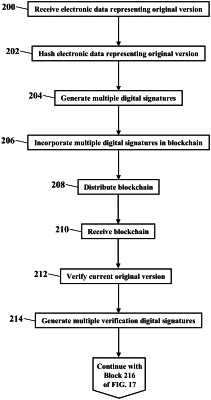| CPC H04L 9/3247 (2013.01) [H04L 9/3236 (2013.01); H04L 63/123 (2013.01); H04L 9/50 (2022.05)] | 17 Claims |

|
1. A method performed by a server that verifies an authenticity of an electronic document shared via a computer network among computers, the method comprising:
receiving, by the server, a blockchain recording a creational hash value representing a created version of the electronic document;
retrieving, by the server, a current metadata associated with a current version of the electronic document shared via the computer network among the computers;
generating, by the server, a current hash value by hashing only the current metadata associated with the current version of the electronic document;
incorporating the current hash value generated by the hashing of only the metadata into the blockchain;
comparing, by the server, the creational hash value received via the blockchain to the current hash value generated by the hashing of only the current metadata associated with the current version of the electronic document;
in response to the current hash value failing to match the creational hash value received via the blockchain, determining, by the server, that the current version of the electronic document shared via the computer network among the computers is not an authentic copy of the original version of the electronic document; and
generating, by the server, a fraud alert indicating the current version is inauthentic.
|